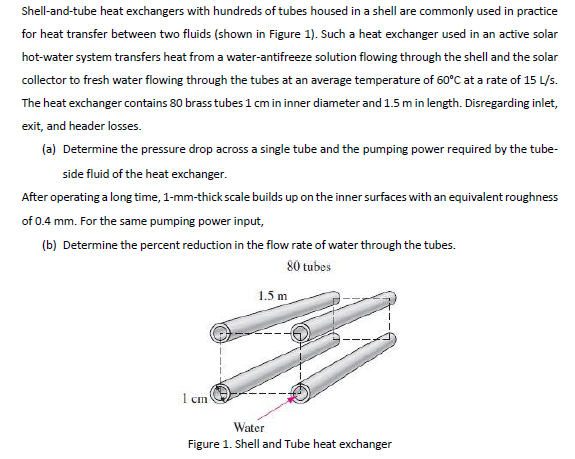Shell-and-tube heat exchangers with hundreds of tubes housed in a shell are commonly used in practice for heat transfer between two fluids (shown in Figure 1). Such a heat exchanger used in an active solar hot-water system transfers heat from a water-antifreeze solution flowing through the shell and the solar collector to fresh water flowing through the tubes at an average temperature of 60°C at a rate of 15 L/s. The heat exchanger contains 80 brass tubes 1 cm in inner diameter and 1.5 m in length. Disregarding inlet, exit, and header losses. (a) Determine the pressure drop across a single tube and the pumping power required by the tube- side fluid of the heat exchanger. After operating a long time, 1-mm-thick scale builds up on the inner surfaces with an equivalent roughness of 0.4 mm. For the same pumping power input, (b) Determine the percent reduction in the flow rate of water through the tubes. 80 tubes 1.5 m I cm Water Figure 1. Shell and Tube heat exchanger
Shell-and-tube heat exchangers with hundreds of tubes housed in a shell are commonly used in practice for heat transfer between two fluids (shown in Figure 1). Such a heat exchanger used in an active solar hot-water system transfers heat from a water-antifreeze solution flowing through the shell and the solar collector to fresh water flowing through the tubes at an average temperature of 60°C at a rate of 15 L/s. The heat exchanger contains 80 brass tubes 1 cm in inner diameter and 1.5 m in length. Disregarding inlet, exit, and header losses. (a) Determine the pressure drop across a single tube and the pumping power required by the tube- side fluid of the heat exchanger. After operating a long time, 1-mm-thick scale builds up on the inner surfaces with an equivalent roughness of 0.4 mm. For the same pumping power input, (b) Determine the percent reduction in the flow rate of water through the tubes. 80 tubes 1.5 m I cm Water Figure 1. Shell and Tube heat exchanger
Principles of Heat Transfer (Activate Learning with these NEW titles from Engineering!)
8th Edition
ISBN:9781305387102
Author:Kreith, Frank; Manglik, Raj M.
Publisher:Kreith, Frank; Manglik, Raj M.
Chapter7: Forced Convection Inside Tubes And Ducts
Section: Chapter Questions
Problem 7.46P
Related questions
Concept explainers
Heat Exchangers
Heat exchangers are the types of equipment that are primarily employed to transfer the thermal energy from one fluid to another, provided that one of the fluids should be at a higher thermal energy content than the other fluid.
Heat Exchanger
The heat exchanger is a combination of two words ''Heat'' and ''Exchanger''. It is a mechanical device that is used to exchange heat energy between two fluids.
Question

Transcribed Image Text:Shell-and-tube heat exchangers with hundreds of tubes housed in a shell are commonly used in practice
for heat transfer between two fluids (shown in Figure 1). Such a heat exchanger used in an active solar
hot-water system transfers heat from a water-antifreeze solution flowing through the shell and the solar
collector to fresh water flowing through the tubes at an average temperature of 60°C at a rate of 15 L/s.
The heat exchanger contains 80 brass tubes 1 cm in inner diameter and 1.5 m in length. Disregarding inlet,
exit, and header losses.
(a) Determine the pressure drop across a single tube and the pumping power required by the tube-
side fluid of the heat exchanger.
After operating a long time, 1-mm-thick scale builds up on the inner surfaces with an equivalent roughness
of 0.4 mm. For the same pumping power input,
(b) Determine the percent reduction in the flow rate of water through the tubes.
80 tubes
1.5 m
I cm
Water
Figure 1. Shell and Tube heat exchanger
Expert Solution
This question has been solved!
Explore an expertly crafted, step-by-step solution for a thorough understanding of key concepts.
This is a popular solution!
Trending now
This is a popular solution!
Step by step
Solved in 5 steps with 10 images

Knowledge Booster
Learn more about
Need a deep-dive on the concept behind this application? Look no further. Learn more about this topic, mechanical-engineering and related others by exploring similar questions and additional content below.Recommended textbooks for you

Principles of Heat Transfer (Activate Learning wi…
Mechanical Engineering
ISBN:
9781305387102
Author:
Kreith, Frank; Manglik, Raj M.
Publisher:
Cengage Learning

Principles of Heat Transfer (Activate Learning wi…
Mechanical Engineering
ISBN:
9781305387102
Author:
Kreith, Frank; Manglik, Raj M.
Publisher:
Cengage Learning